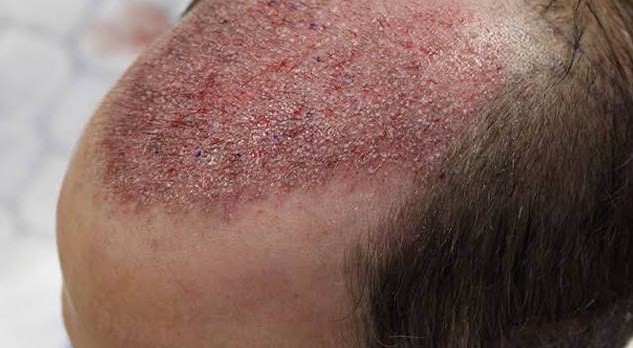Hair transplant surgery is a safe and effective solution for hair loss when performed by experienced professionals. However, like any surgical procedure, it carries a small risk of complications—infection being one of the most common concerns.
While infections after hair transplants are rare, they can negatively affect healing, cause discomfort, and in severe cases, threaten the success of the grafts. The good news is that most infections are preventable and treatable when addressed early.
In this article, we’ll cover:
Why infections happen after hair transplants
What signs to look out for
How to prevent infection
Effective treatment options
When to seek medical help
Why Do Infections Happen After a Hair Transplant?
Hair transplant procedures involve creating thousands of tiny incisions in the scalp to extract and implant follicles. Although these wounds are small, they are still entry points for bacteria if not cared for properly.
Some common reasons for infection include:
Poor hygiene during the healing process
Scratching the scalp with dirty hands or nails
Excessive sweating
Using non-sterile headwear or pillowcases
Skipping prescribed medications or aftercare steps
Most infections develop within the first 7 to 10 days after the procedure. However, late-onset infections can also occur if grafts are irritated or exposed to unclean conditions weeks later.
Signs of Infection After Hair Transplant Surgery
Knowing what’s normal and what’s not is key to early detection. Some redness, swelling, and sensitivity are common in the first few days, but you should monitor for signs that may indicate an infection.
⚠️ Symptoms of Infection:
Increasing redness that spreads beyond the graft area
Swelling that worsens instead of improves
Pus or yellow/green discharge from the transplant site
Pain that becomes more intense over time
Foul odor from the scalp
Crusting or sores that do not heal
Fever, chills, or a general feeling of being unwell
If you notice one or more of these symptoms, don’t delay—contact your surgeon immediately.
How to Prevent Infection After a Hair Transplant
The best way to deal with infection is to prevent it from occurring in the first place. A few simple but important steps can protect your scalp and ensure a smooth recovery.
✅ 1. Follow Post-Operative Instructions Carefully
Your clinic will give you a set of written or verbal aftercare guidelines. These instructions cover when and how to wash your hair, what to avoid, and which products to use. Following them is critical.
✅ 2. Keep the Area Clean and Dry
Avoid touching your scalp unnecessarily.
Use only surgeon-approved shampoos and saline sprays.
Pat dry gently—never rub or scrub.
Change your pillowcase daily and sleep on clean bedding.
✅ 3. Take Prescribed Medications on Time
If your surgeon gives you antibiotics, take the full course—even if you feel fine. These help protect against bacterial infection during the critical healing phase.
✅ 4. Avoid Sweat and Dust
Do not exercise, go to saunas, or expose your scalp to dust for at least 10–14 days.
Excessive sweating increases bacteria and can lead to infection.
Stay indoors or in clean environments as much as possible.
✅ 5. Don’t Scratch the Scalp
Itching is common, but scratching with nails introduces bacteria. If the itch becomes unbearable, ask your doctor about safe remedies or moisturizers.
✅ 6. Don’t Use Hair Products Without Approval
Hair gels, sprays, oils, and dyes should be avoided during healing. Many of these products contain chemicals that can irritate or infect healing wounds.
Treatment Options for Infections After Hair Transplant
If an infection is diagnosed early, it can usually be treated without affecting your final results. Here’s how it’s typically managed:
🧴 Topical Antibiotic Creams
Doctors may prescribe a cream or ointment to apply directly to the affected area. These help fight surface bacteria and reduce local inflammation.
💊 Oral Antibiotics
For more serious infections, a course of oral antibiotics is prescribed. Be sure to complete the entire dosage—even if symptoms disappear early.
💆♂️ Proper Scalp Hygiene
Continue to wash and clean the scalp as directed. If crusts or scabs are present, your doctor may suggest soaking or using specific shampoos.
⚕️ Follow-Up Appointments
Never skip post-op checkups. Surgeons can catch early signs of infection and take action before it spreads.
Can Infections Damage Hair Grafts?
Yes—if left untreated, infections can:
Cause grafts to fall out prematurely
Slow down hair growth
Lead to visible scarring or patchy results
Extend your recovery time
That’s why early action is vital. Most mild infections, when treated promptly, do not affect the final outcome of your hair transplant.
When to Call Your Doctor Immediately
If you experience any of the following, you should call your surgeon right away:
Fever over 38°C (100.4°F)
Intense throbbing pain in the scalp
Rapid spreading redness or swelling
Any kind of pus or drainage
Feeling faint, weak, or feverish
Final Thoughts
Infections after a hair transplant are uncommon, but they can occur—especially if post-operative care is neglected. The best approach is to be proactive, stay clean, and follow your doctor’s instructions to the letter.
By maintaining good hygiene, avoiding irritants, and acting quickly at the first sign of trouble, you can safeguard your results and enjoy the benefits of your hair restoration for years to come.
Remember, your scalp is vulnerable after surgery—treat it with care, and it will reward you with strong, healthy, and lasting hair growth.

Bir yanıt yazın